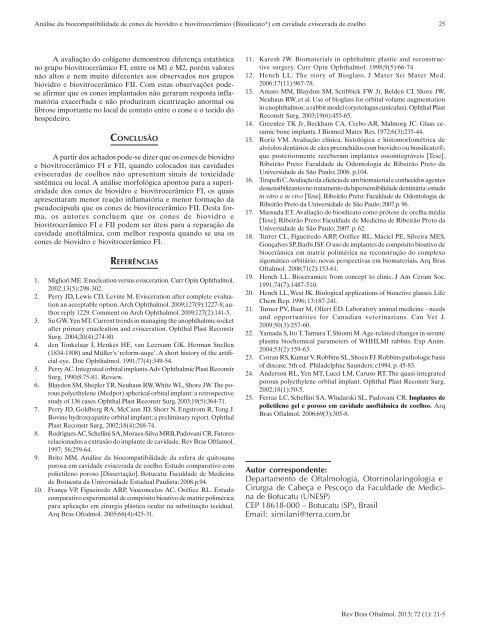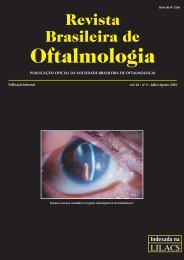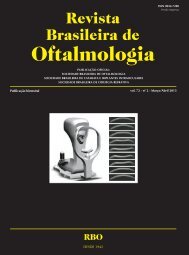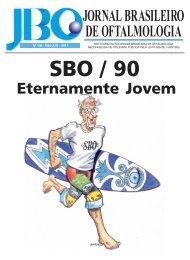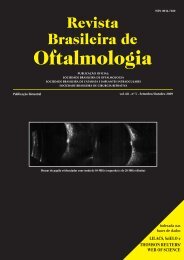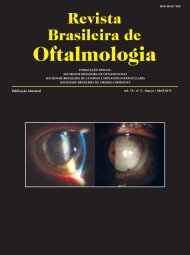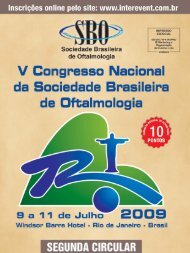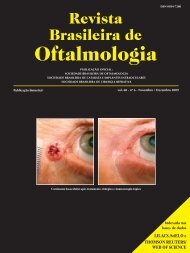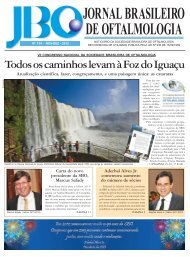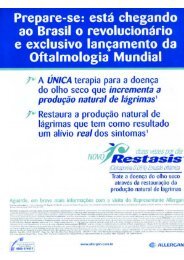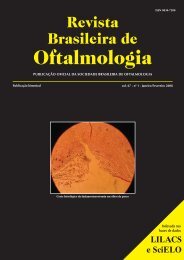to download PDF in portuguese - Sociedade Brasileira de ...
to download PDF in portuguese - Sociedade Brasileira de ...
to download PDF in portuguese - Sociedade Brasileira de ...
Create successful ePaper yourself
Turn your PDF publications into a flip-book with our unique Google optimized e-Paper software.
Análise da biocompatibilida<strong>de</strong> <strong>de</strong> cones <strong>de</strong> biovidro e biovitrocerâmico (Biosilica<strong>to</strong> ® ) em cavida<strong>de</strong> eviscerada <strong>de</strong> coelho<br />
25<br />
A avaliação do colágeno <strong>de</strong>monstrou diferença estatística<br />
no grupo biovitrocerâmico FI, entre os M1 e M2, porém valores<br />
não al<strong>to</strong>s e nem mui<strong>to</strong> diferentes aos observados nos grupos<br />
biovidro e biovitrocerâmico FII. Com estas observações po<strong>de</strong>se<br />
afirmar que os cones implantados não geraram resposta <strong>in</strong>flamatória<br />
exacerbada e não produziram cicatrização anormal ou<br />
fibrose importante no local <strong>de</strong> conta<strong>to</strong> entre o cone e o tecido do<br />
hospe<strong>de</strong>iro.<br />
CONCLUSÃO<br />
A partir dos achados po<strong>de</strong>-se dizer que os cones <strong>de</strong> biovidro<br />
e biovitrocerâmico FI e FII, quando colocados nas cavida<strong>de</strong>s<br />
evisceradas <strong>de</strong> coelhos não apresentam s<strong>in</strong>ais <strong>de</strong> <strong>to</strong>xicida<strong>de</strong><br />
sistêmica ou local. A análise morfológica apon<strong>to</strong>u para a superiorida<strong>de</strong><br />
dos cones <strong>de</strong> biovidro e biovitrocerâmico FI, os quais<br />
apresentaram menor reação <strong>in</strong>flamatória e menor formação da<br />
pseudocápsula que os cones <strong>de</strong> biovitrocerâmico FII. Desta forma,<br />
os au<strong>to</strong>res concluem que os cones <strong>de</strong> biovidro e<br />
biovitrocerâmico FI e FII po<strong>de</strong>m ser úteis para a reparação da<br />
cavida<strong>de</strong> anoftálmica, com melhor resposta quando se usa os<br />
cones <strong>de</strong> biovidro e biovitrocerâmico FI.<br />
REFERÊNCIAS<br />
1. Migliori ME. Enucleation versus evisceration. Curr Op<strong>in</strong> Ophthalmol.<br />
2002;13(5):298-302.<br />
2. Perry JD, Lewis CD, Lev<strong>in</strong>e M. Evisceration after complete evaluation<br />
an acceptable option. Arch Ophthalmol. 2009;127(9):1227-8; author<br />
reply 1229. Comment on Arch Ophthalmol. 2009;127(2):141-5.<br />
3. Su GW, Yen MT. Current trends <strong>in</strong> manag<strong>in</strong>g the anophthalmic socket<br />
after primary enucleation and evisceration. Ophthal Plast Reconstr<br />
Surg. 2004;20(4):274-80.<br />
4. <strong>de</strong>n Tonkelaar I, Henkes HE, van Leersum GK. Herman Snellen<br />
(1834-1908) and Müller’s ‘reform-auge’. A short his<strong>to</strong>ry of the artificial<br />
eye. Doc Ophthalmol. 1991;77(4):349-54.<br />
5. Perry AC. Integrated orbital implants. Adv Ophthalmic Plast Reconstr<br />
Surg. 1990;8:75-81. Review.<br />
6. Blaydon SM, Shepler TR, Neuhaus RW, White WL, Shore JW. The porous<br />
polyethylene (Medpor) spherical orbital implant: a retrospective<br />
study of 136 cases. Ophthal Plast Reconstr Surg. 2003;19(5):364-71.<br />
7. Perry JD, Goldberg RA, McCann JD, Shorr N, Engstrom R, Tong J.<br />
Bov<strong>in</strong>e hydroxyapatite orbital implant: a prelim<strong>in</strong>ary report. Ophthal<br />
Plast Reconstr Surg. 2002;18(4):268-74.<br />
8. Rodrigues AC, Schell<strong>in</strong>i SA, Moraes-Silva MRB, Padovani CR. Fa<strong>to</strong>res<br />
relacionados a extrusão do implante <strong>de</strong> cavida<strong>de</strong>. Rev Bras Oftlamol.<br />
1997; 56:259-64.<br />
9. Bri<strong>to</strong> MM. Análise da biocompatibilida<strong>de</strong> da esfera <strong>de</strong> qui<strong>to</strong>sana<br />
porosa em cavida<strong>de</strong> eviscerada <strong>de</strong> coelho. Estudo comparativo com<br />
polietileno poroso [Dissertação]. Botucatu: Faculda<strong>de</strong> <strong>de</strong> Medic<strong>in</strong>a<br />
<strong>de</strong> Botucatu da Universida<strong>de</strong> Estadual Paulista; 2008.p.94.<br />
10. França VP, Figueiredo ARP, Vasconcelos AC, Oréfice RL. Estudo<br />
comparativo experimental <strong>de</strong> compósi<strong>to</strong> bioativo <strong>de</strong> matriz polimérica<br />
para aplicação em cirurgia plástica ocular na substituição tecidual.<br />
Arq Bras Oftalmol. 2005;68(4):425-31.<br />
11. Karesh JW. Biomaterials <strong>in</strong> ophthalmic plastic and reconstructive<br />
surgery. Curr Op<strong>in</strong> Ophthalmol. 1998;9(5):66-74<br />
12. Hench LL. The s<strong>to</strong>ry of Bioglass. J Mater Sci Mater Med.<br />
2006;17(11):967-78.<br />
13. Ama<strong>to</strong> MM, Blaydon SM, Scribbick FW Jr, Bel<strong>de</strong>n CJ, Shore JW,<br />
Neuhaus RW, et al. Use of bioglass for orbital volume augmentation<br />
<strong>in</strong> enophthalmos: a rabbit mo<strong>de</strong>l (oryc<strong>to</strong>lagus cuniculus). Ophthal Plast<br />
Reconstr Surg. 2003;19(6):455-65.<br />
14. Greenlee TK Jr, Beckham CA, Crebo AR, Malmorg JC. Glass ceramic<br />
bone implants. J Biomed Mater Res. 1972;6(3):235-44.<br />
15. Roriz VM. Avaliação clínica, his<strong>to</strong>lógica e his<strong>to</strong>morfométrica <strong>de</strong><br />
alvéolos <strong>de</strong>ntários <strong>de</strong> cães preenchidos com biovidro ou biosilica<strong>to</strong>®,<br />
que posteriormente receberam implantes osso<strong>in</strong>tegráveis [Tese].<br />
Ribeirão Pre<strong>to</strong>: Faculda<strong>de</strong> <strong>de</strong> Odon<strong>to</strong>logia <strong>de</strong> Ribeirão Pre<strong>to</strong> da<br />
Universida<strong>de</strong> <strong>de</strong> São Paulo; 2006. p.104.<br />
16. Tirapelli C. Avaliação da eficácia <strong>de</strong> um biomaterial e conhecidos agentes<br />
<strong>de</strong>ssensibilizantes no tratamen<strong>to</strong> da hipersensibilida<strong>de</strong> <strong>de</strong>nt<strong>in</strong>ária: estudo<br />
<strong>in</strong> vitro e <strong>in</strong> vivo [Tese]. Ribeirão Pre<strong>to</strong>: Faculda<strong>de</strong> <strong>de</strong> Odon<strong>to</strong>logia <strong>de</strong><br />
Ribeirão Pre<strong>to</strong> da Universida<strong>de</strong> <strong>de</strong> São Paulo; 2007.p. 96.<br />
17. Massuda ET. Avaliação do biosilica<strong>to</strong> como prótese <strong>de</strong> orelha média<br />
[Tese]. Ribeirão Pre<strong>to</strong>: Faculda<strong>de</strong> <strong>de</strong> Medic<strong>in</strong>a <strong>de</strong> Ribeirão Pre<strong>to</strong> da<br />
Universida<strong>de</strong> <strong>de</strong> São Paulo; 2007. p. 62.<br />
18. Turrer CL, Figueiredo ARP, Oréfice RL, Maciel PE, Silveira MES,<br />
Gonçalves SP, Barbi JSF. O uso <strong>de</strong> implantes <strong>de</strong> compósi<strong>to</strong> bioativo <strong>de</strong><br />
biocerâmica em matriz polimérica na reconstrução do complexo<br />
zigomático orbitário: novas perspectivas em biomateriais. Arq Bras<br />
Oftalmol. 2008;71(2):153-61.<br />
19. Hench LL. Bioceramics: from concept <strong>to</strong> cl<strong>in</strong>ic. J Am Ceram Soc.<br />
1991;74(7):1487-510.<br />
20. Hench LL, West JK. Biological applications of bioactive glasses. Life<br />
Chem Rep. 1996; 13:187-241.<br />
21. Turner PV, Baar M, Olfert ED. Labora<strong>to</strong>ry animal medic<strong>in</strong>e - needs<br />
and opportunities for Canadian veter<strong>in</strong>arians. Can Vet J.<br />
2009;50(3):257-60.<br />
22. Yamada S, I<strong>to</strong> T, Tamura T, Shiomi M. Age-related changes <strong>in</strong> serum/<br />
plasma biochemical parameters of WHHLMI rabbits. Exp Anim.<br />
2004;53(2):159-63.<br />
23. Cotran RS, Kumar V, Robb<strong>in</strong>s SL, Shoen FJ. Robb<strong>in</strong>s pathologic basis<br />
of disease. 5th ed. Phila<strong>de</strong>lphia: Saun<strong>de</strong>rs; c1994. p. 45-83.<br />
24. An<strong>de</strong>rson RL, Yen MT, Lucci LM, Caruso RT. The quasi-<strong>in</strong>tegrated<br />
porous polyethylene orbital implant. Ophthal Plast Reconstr Surg.<br />
2002;18(1):50-5.<br />
25. Ferraz LC, Schell<strong>in</strong>i SA, Wludarski SL, Padovani CR. Implantes <strong>de</strong><br />
polietileno gel e poroso em cavida<strong>de</strong> anoftálmica <strong>de</strong> coelhos. Arq<br />
Bras Oftalmol. 2006;69(3):305-8.<br />
Au<strong>to</strong>r correspon<strong>de</strong>nte:<br />
Departamen<strong>to</strong> <strong>de</strong> Oftalmologia, O<strong>to</strong>rr<strong>in</strong>olar<strong>in</strong>gologia e<br />
Cirurgia <strong>de</strong> Cabeça e Pescoço da Faculda<strong>de</strong> <strong>de</strong> Medic<strong>in</strong>a<br />
<strong>de</strong> Botucatu (UNESP)<br />
CEP 18618-000 – Botucatu (SP), Brasil<br />
Email: similani@terra.com.br<br />
Rev Bras Oftalmol. 2013; 72 (1): 21-5


